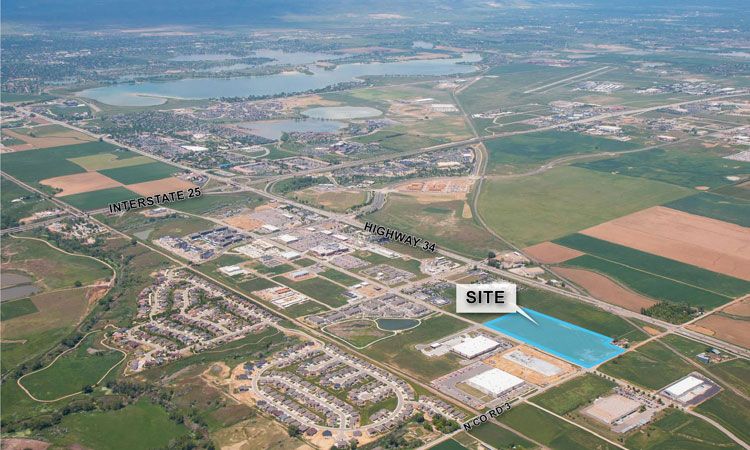U.S. 34 emerges as vital economic artery in heart of NoCo

If Interstate 25, connecting Fort Collins in the north to the Denver metro area in the south, is Northern Colorado’s transportation backbone, then perhaps an apt bodily comparison for U.S. Highway 34 is to the region’s shoulder blades, making the east-west link between Loveland and Greeley.
This metaphorical Northern Colorado transit skeleton has been putting in extra upper body pumps at the gym, steadily building muscle on its shoulders and outstretched arms.
The U.S. 34 corridor, particularly at its nexus with I-25, has seen an economic growth spurt in recent years with a handful of developers building dozens of new shops and restaurants, hundreds of apartment units, thousands of homes and millions of square feet of commercial and industrial space.
SPONSORED CONTENT
The many benefits of simple, coordinated healthcare
Kaiser Permanente combines health care and coverage in one connected system to maximize employee health and minimize employer costs.
“The communities of Fort Collins and Loveland and Greeley have grown from the inside out,” said Ryan Schaefer, CEO of Fort Collins-based real estate brokerage NAI Affinity.
Those outward expansions — Shaefer likes to visualize this process using the image of concentric circles — collide near the U.S. 34 and I-25 interchange in Johnstown.
“You’ve got the highest traffic counts of anywhere in the region along I-25 and U.S. Highway 34,” he said.
And with traffic comes opportunity.
“The 100,000-plus cars driving up and down I-25 everyday was the big driver for us,” Arizona-based developer CaliberCos. Inc. chief development officer Roy Bade said of the company’s decision to plant its flag in Northern Colorado.
Caliber is building two large master-planned, mixed-use projects in Johnstown that total more than 500 acres: The Ridge at Interstate 25 and Freedom Parkway, and Encore off U.S. 34.
“At Encore, we have an additional 65,000 cars a day going east-west [on U.S. 34],” Bade said. “When you have 165,000 cars within a mile and a half of your projects, that’s a lot of volume and that’s really important to us.”
Schaefer echoed this point about the importance of a steady regional flow of would-be customers, employees and homeowners.
“I-25 is a big part of the economic lifeblood of our region,” he said. “We need employees to be able to get to and from the Denver metro, to Denver International Airport. It’s vital for our economy.”
In addition to Caliber’s projects, the area around the U.S. 34 and I-25 junction is home to McWhinney Real Estate Services Inc.’s Centerra mega-development and the company’s new 630-acre housing development called Kinston, which will include 2,800 home sites and, in 10 to 15 years, will accommodate about 8,000 residents.
“It’s called Centerra for a reason,” McWhinney executive vice president of master planned communities Peter Lauener said, “and that’s because it’s the center of Northern Colorado at I-25 and U.S. 34. It’s a strong regional economic driver..”
Adjacent to Kinston and the Caliber projects is 2534, a 100-plus-acre mixed-use district with a large retail pad anchored by a 250,000-square-foot Scheels sporting goods store.
“You have the highest concentration of retail [shops] in Northern Colorado near the I-24 and U.S. 34 interchange,” Schaefer said. “There are shoppers coming from all over the region to that area.”
It’s not just homes and big box stores sprouting up in the region.
“All of the industrial development that’s going on is part of the story as well,” Schaefer said. “There are millions of square feet of Class A industrial being developed within a four mile radius of I-25 and U.S. 34.”
United Properties Development LLC this year closed on the purchase of 16.76 acres of land in the 2534 commercial development and is building a three-building flexible industrial space totaling 280,323 square feet.
“With this new project, 2534 will have seen over 600,000 square feet of Class A Industrial development since 2016, making it one of the hottest industrial locations in the region,” Gary Gerrard, master developer of 2534, said in a written statement issued after the United Properties land purchase in May.
In Loveland, to the east of the I-25 and U.S. 34 interchange, an especially intriguing industrial project is taking root.
A 152-acre parcel of land near Northern Colorado Regional Airport has been annexed by Loveland and is set to be the site of a more than 1 million-plus square-foot fulfillment and distribution facility that is widely suspected will be occupied by Amazon Inc. (Nasdaq: AMZN) upon completion. Dallas-based Trammell Crow Co. is developing the site with Langan Engineering & Environmental Services Inc. of Parsippany, New Jersey. Trammell Crow and Langan have previously worked with Seattle-based Amazon on projects, including an 850,000-square-foot fulfillment center on 93 acres in Richmond, Texas, begun in 2020 and set for completion this year.
“The area around the intersection of I-25 and U.S. 34 has been very popular with distribution users because they can serve all of Northern Colorado from this central geographic point,” McWhinney vice president of commercial development Clyde Wood said.
Users at McWhinney’s industrial sites, of course, aren’t limited to package distributors. Centerra is home to tenants as diverse as the NORCO Volleyball facility to agricultural product makers.
Across the interstate in Johnstown, McWhinney is in the process of developing the Iron Horse Business Park, a commerce center that could eventually be home to 30 buildings and about 2.5 million square feet of space.
To the west along U.S. 34 in Greeley, developers are working through the city’s final platting and planning process for the 84-acre Westgate project.
Westgate, which is located west of 71st Avenue and east of 83rd Avenue and is being planned by an affiliate of The Broe Group, is set to include 28 acres for 191 single-family homes, most on 6,000-square-foot lots, and about 16 acres for 288 apartments. About 22 acres will be set aside for parks and landscaping and another seven acres is set for commercial space.
Between Loveland and Greeley is the roughly 1,000-acre property known as Apex Vista, which is just west of the intersection of U.S. Highway 34 and Weld County Road 17.
That property has been marketed as having the potential to become “the next Centerra,” according to NAI Affinity brokers.
Part of the reason why these large, mixed-use developments have proven successful in Northern Colorado is the willingness of local governments to approve the establishment of metro districts. This system allows developers to issue bonds to fund infrastructure and amenities that will be repaid by future residents.
“We’re selling land [to end users] at a discount [compared to prices users pay in other markets where Caliber operates]. Metro districts help match up that margin and help you get back some of those infrastructure dollars” spent in the early stages of development, Bade said. “It effectively adds value to your land and allows you to sell it at a profit after it’s improved.”
Infrastructure improvements are necessary not only within the bounds of new developments, but along the major roadways that make up the Northern Colorado transportation skeleton.
The Colorado Department of Transportation is in the middle of a series of expansion and improvement projects along a stretch of Interstate 25 in Northern Colorado, most of which center on adding a lane and replacing bridges between Mead and Fort Collins.
“I think that in the short term, there are always concerns about new projects and the burden those place on existing infrastructure,” Schaefer said. “But generally, over time, those projects tend to fund more than their fair share of infrastructure. It does catch up.”
With growth along the U.S. 34 corridor showing no signs of slowing, local real estate and economic development leaders are left to speculate about what the region could look like in the decades to come.
“This [area] is very unique in that it’s in the heart of multiple communities that are growing together,” Schaefer said. “I think we’re going to see more growth go forward into the future heading east on U.S. 34. You’ll start to see additional development heading out toward Windsor and Greeley.”
As the surrounding communities converge, Schaefer predicts the corridor could end up looking “a lot like the Denver Tech Center or Highlands Ranch, but Northern Colorado’s version.”
Editor’s note: This story has been update to correct Roy Bade’s title with Caliber.
If Interstate 25, connecting Fort Collins in the north to the Denver metro area in the south, is Northern Colorado’s transportation backbone, then perhaps an apt bodily comparison for U.S. Highway 34 is to the region’s shoulder blades, making the east-west link between Loveland and Greeley.
This metaphorical Northern Colorado transit skeleton has been putting in extra upper body pumps at the gym, steadily building muscle on its shoulders and outstretched arms.
The U.S. 34 corridor, particularly at its nexus with I-25, has seen an economic growth spurt in recent years with a handful of developers building dozens of new shops and…
THIS ARTICLE IS FOR SUBSCRIBERS ONLY
Continue reading for less than $3 per week!
Get a month of award-winning local business news, trends and insights
Access award-winning content today!


